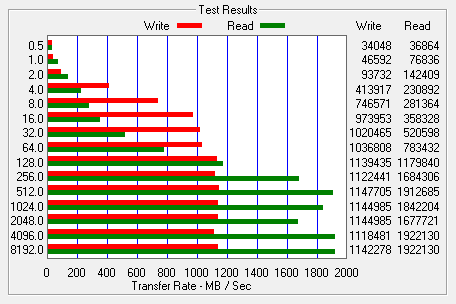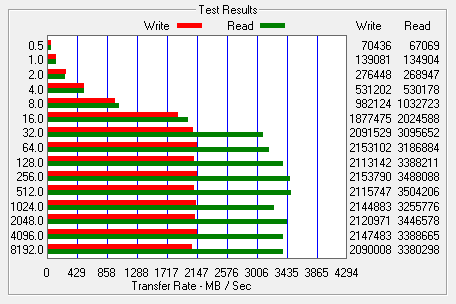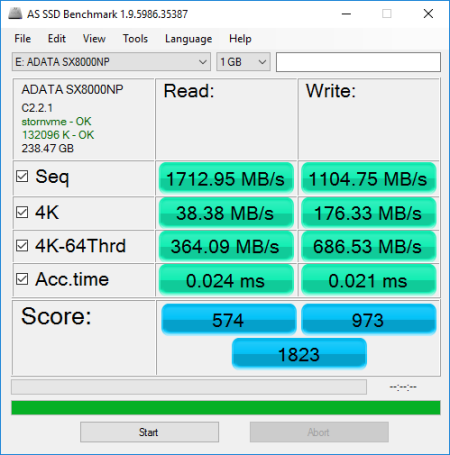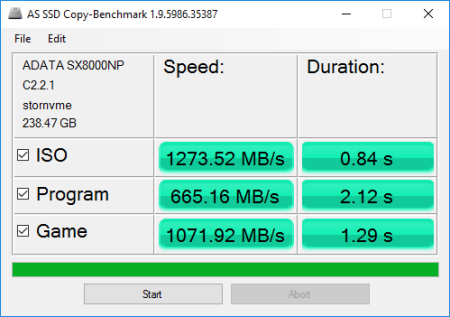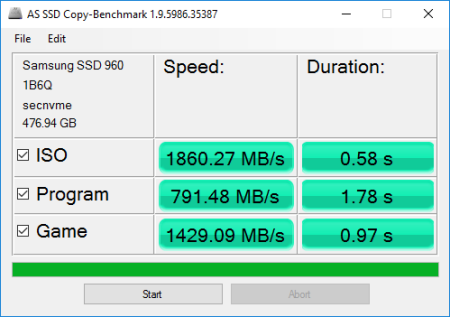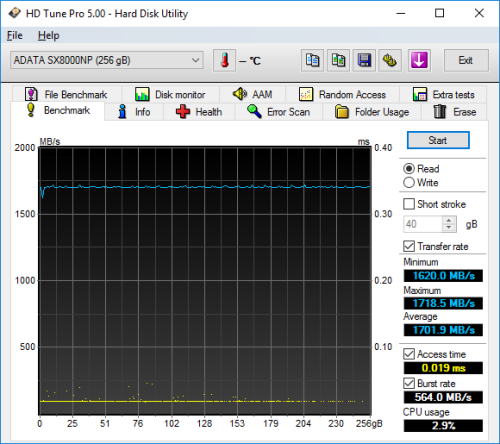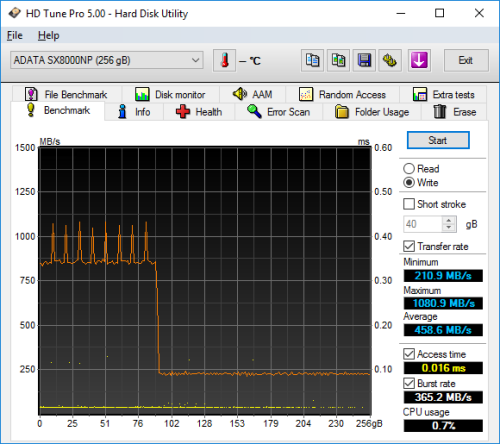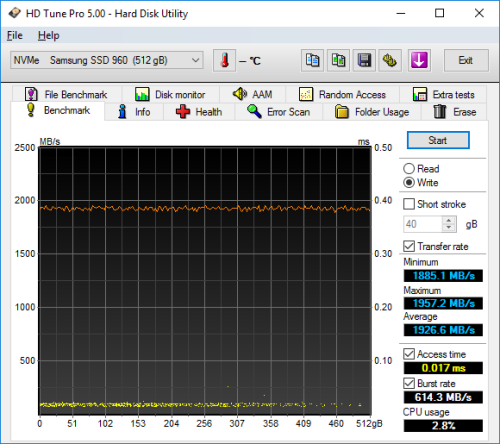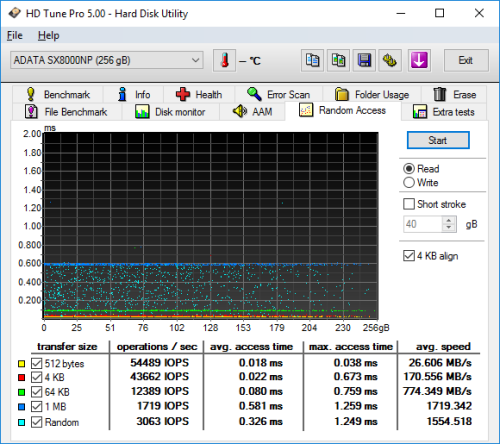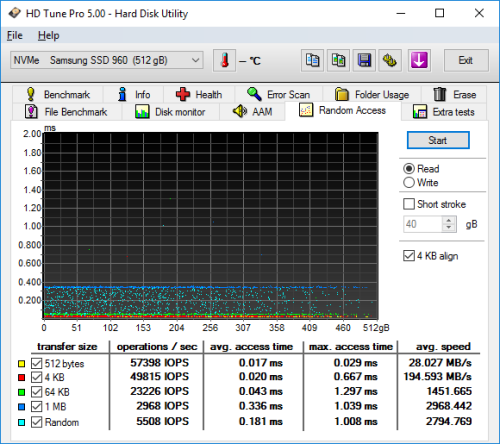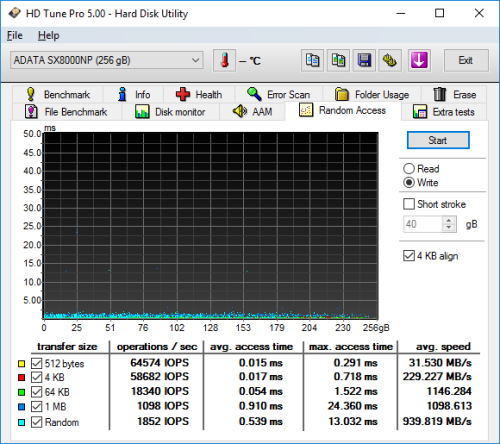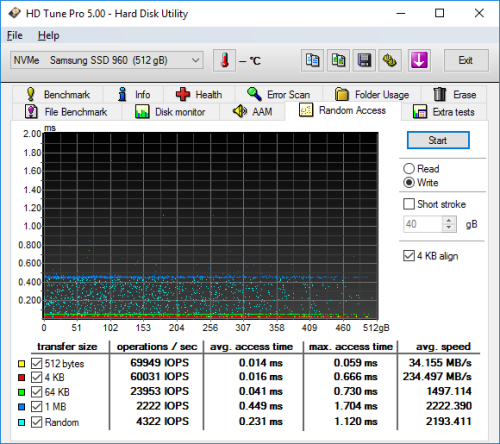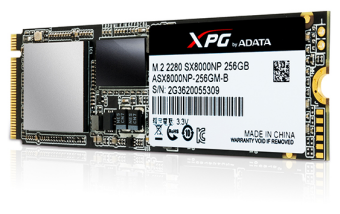

Model: ADATA XPG SX8000 256GB PCIe M.2 Solid State Drive
Manufacturer: ADATA Technology
Provided By: ADATA Technology (USA)
ADATA Technology is one of the world's leading manufacturers of high performance memory modules and data storage solutions. Founded in 2001 with a staff of 20, this Taiwanese company set itself apart from the competition early on thanks to its professionalism, industry know-how and eye-catching product designs. Today, ADATA continues to lead the way through constant innovation and development of products that exceed customer expectations. Backed by technical expertise, state-of-the-art manufacturing facilities and premium customer service, ADATA currently offers a variety of products including DRAM modules, USB flash drives, memory cards, solid state drives and portable hard drives.
Last fall, ADATA launched its first PCIe NVMe SSD, the XPG SX8000. Designed to deliver massive speed for gaming notebooks and high-end desktops, this M.2 form factor drive is powered by Silicon Motion's new SM2260 controller and is available with up to 1TB of 3D MLC NAND flash. In addition to providing higher storage density, 3D NAND offers greater efficiency and reliability than what you'd see with traditional 2D NAND flash. The SX8000 also meets NVMe 1.2 specifications and is equipped with an ultra-fast PCIe Gen 3.0 x4 interface to deliver four times the read and twice the write performance of average SATA 6Gb/s SSDs.
The XPG SX8000 is available in 128GB, 256GB, 512GB and 1TB capacities. For this review, ADATA sent us the 256GB version of the drive which is capable of delivering up to 2,000 MB/s sequential read and 1,000 MB/s sequential write speeds as well as up to 85,000 random read and 140,000 random write IOPS.
| ADATA XPG SX8000 256GB PCIe M.2 Solid State Drive | |||||||||||||||||||||||||||||||||||||||||
General Specifications
Performance
Reliability
Power Consumption
Environmental
Dimensions and Weight
Other Features
|
Needless to say, this is only a taste of what the XPG SX8000 has to offer. To give you an idea of what to expect, we'll take a closer look at ADATA's new NVMe SSD and then see how well it performs. Does the SX8000 have what it takes? More importantly, is it the best bang for your buck? Keep reading as we find out.
The XPG SX8000 comes in a small eye-catching, red and black box. Along with a picture of the drive, the front advertises many of its key features including its 256GB capacity, PCIe Gen3x4 interface, NVMe 1.2 support and 3D NAND. The back of the box provides a bit more information regarding the SX8000's features and performance.

For whatever reason, ADATA opted not to include any sort of documentation with the SX8000. While gamers and enthusiasts probably don't need help installing the drive in their computer, it still would have been good to include some warranty and service information.
Physical Features:
The XPG SX8000 uses the 2280 form factor for M.2 (NGFF) SSDs. It measures 22 x 80 x 3.5 mm and tips the scales at a mere 8g. The drive also has an "M key" edge connector which provides PCIe SSDs with up to 4x lanes of bandwidth.

The SX8000 is one of the first drives to use SMI's new SM2260 controller. This 8 channel, PCIe Gen 3 x4 SSD controller is powered by a dual ARM Cortex CPU and offers support for MLC, TLC and 3D NAND flash from all the major suppliers. The SM2260 also employs SMI's proprietary NANDXtend ECC technology, which uses LDPC hard and soft decoding as well as RAID protection to enhance the P/E cycles of 3D NAND.


For the 256GB version of the SX8000, ADATA has opted to use its own Micron manufactured 3D MLC NAND flash. Looking at the picture above, you can see that there are two 64GB NAND flash packages on either side of the PCB. The drive also has a pair of 128MB NANYA DDR3L memory chips that are used for caching.
The test system used in this review is equipped with an Intel Core i7-6700K CPU, GIGABYTE GA-Z170X-UD3 motherboard, 32GB (16GB x 2) of Crucial Ballistix Sport LT DDR4 memory, ADATA SU800 512GB SSD and a GIGABYTE GeForce GTX 1060 WINDFORCE OC 6G graphics card. For the operating system, I installed a fresh copy of Windows 10 Enterprise.
To test the performance of ADATA's XPG SX8000 SSD, I ran a series of benchmarks using CrystalDiskMark, HD Tach RW, ATTO Disk Benchmark, AS SSD, HD Tune Pro, Anvil's Storage Utilities, Iometer and PCMark 8. For comparison, I've also included test results from the Samsung 960 PRO, Toshiba OCZ RD400, Samsung 950 PRO, Toshiba OCZ VX500, ADATA Ultimate SU800, Plextor S2C, Crucial M300, Plextor M7V, PNY CS1311, OCZ Trion 150, PNY CS2211, Plextor M6V, Crucial BX200, OCZ Trion 100, Kingston HyperX Savage, Crucial MX200, OCZ Vector 180, Samsung SSD 850 EVO and Samsung SSD 850 PRO.
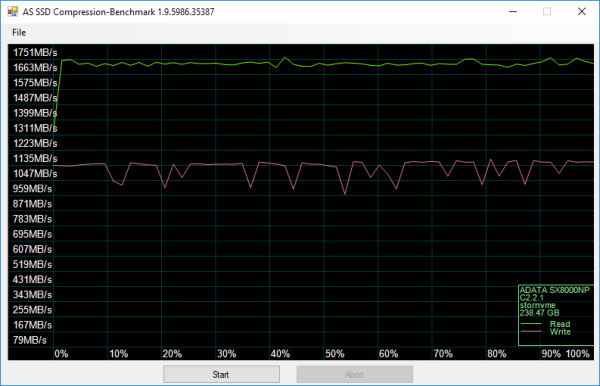
As I mentioned earlier, the XPG SX8000 is based on SMI's SM2260 controller chip. Looking at the screenshot above, you can see that it performs equally well with both incompressible (0%) and compressible (100%) data.
CrystalDiskMark 5.0.3:
First, I ran a few quick tests using CrystalDiskMark. This benchmark tool measures the performance of a storage device by testing its sequential read and write speeds as well as its random read and write speeds using blocks 512K and 4K in size.
According to ADATA, the 256GB version of the SX8000 is capable of reading at 2,000 MB/s and writing at 1,100 MB/s. Looking at the screenshot above, you can see that the drive had no problems reaching these speeds in CrystalDiskMark's sequential read and write tests.
HD Tach RW 3.0.4.0:
Next, I used HD Tach to test the SX8000's read, write and burst speeds as well as its seek times and CPU usage.
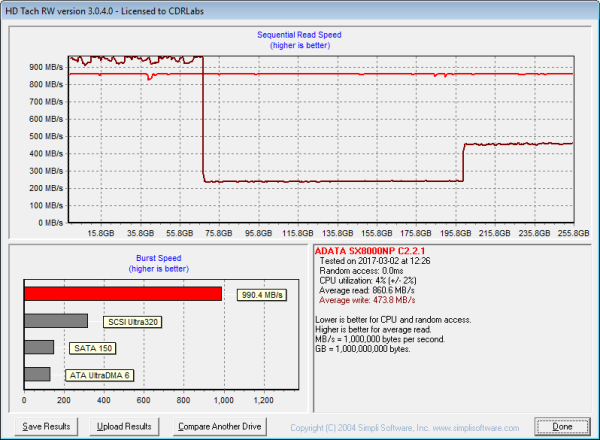
ADATA XPG SX8000 256GB
Looking at the screenshot above, you can see that the SX8000 had average read and write speeds of 860.6 MB/s and 473.8 MB/s respectively, as well as a burst speed of 990.4 MB/s. The screenshot also shows that, unlike most other MLC-based SSDs, the SX8000 uses some sort of SLC caching. The drive starts writing at about 950 MB/s and then drops to about 275 MB/s when the write operation exceeds the size of the cache.
ATTO Disk Benchmark 2.46:
I also used ATTO Disk Benchmark to test the SX8000's sequential read and write speeds. The tests are run using blocks ranging in size from 0.5KB to 8192KB and the total length set to 256MB.
When tested with ATTO, the SX8000's read speeds topped out at about 1,922 MB/s and its write speeds at 1,147 MB/s.
AS SSD:
AS SSD is a relatively new benchmark designed specifically for solid state drives. The application contains five synthetic tests used to determine the sequential and random read and write performance of a drive.
AS SSD also includes a copy benchmark. This test copies an ISO (two large files), program (many small files) and game (small and large files), returning the speed and duration of each.
HD Tune Pro 5.00:
Next, I ran a series of tests using HD Tune Pro. This hard disk utility measures a drive's performance by testing its sequential read and write speeds as well as its access time, burst rate and CPU usage. For this review, I'm also going to use it to benchmark the SX8000's random read and write speeds, random access times and the number of operations per second.
The SX8000 performed relatively well when benchmarked with HD Tune. The drive had average read and write speeds of 1701.9 MB/s and 458.6 MB/s, respectively, and a burst rate of 564.0 MB/s when reading.
The SX8000 didn't disappoint when doing random reads and writes. When reading 4KB blocks, the drive reached 43,662 IOPS and had an average speed of 170.556 MB/s. It was even faster when writing, reaching 58,682 IOPS with an average speed of 229.227 MB/s.
Anvil's Storage Utilities:
Anvil's Storage Utilities is another benchmark designed with SSDs in mind. The standard storage benchmark measures a drive's performance by testing its transfer speeds, access times and IOPS.

Iometer:
Lastly, I ran a series of tests using Iometer. This tool can be configured to benchmark a number of things. In this case, I used it to measure the SX8000's read and write speeds and the number of operations per second. The tests were run using random bytes and a queue depth of 3.

The SX8000's performance was very similar to what we saw in our other tests. The drive was able to read at 1952.76 MB/s and write at 1105.29 MB/s.
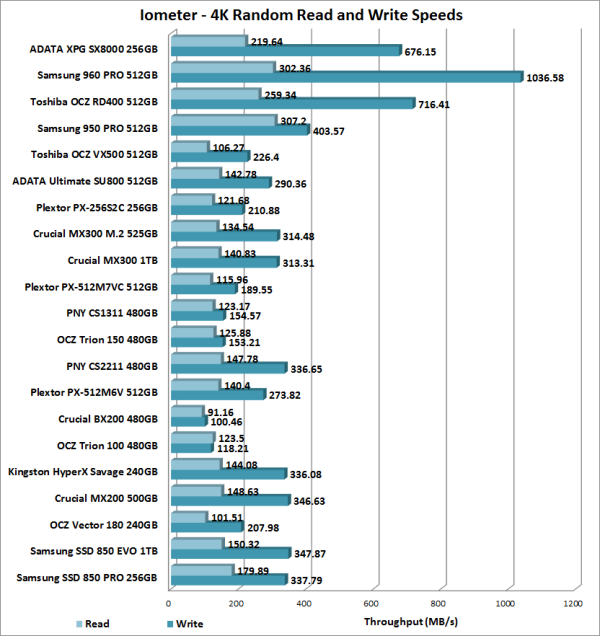
The SX8000 also performed very well when doing random reads and writes. In our tests, the drive was able to read at 219.64 MB/s and write at 676.15 MB/s.
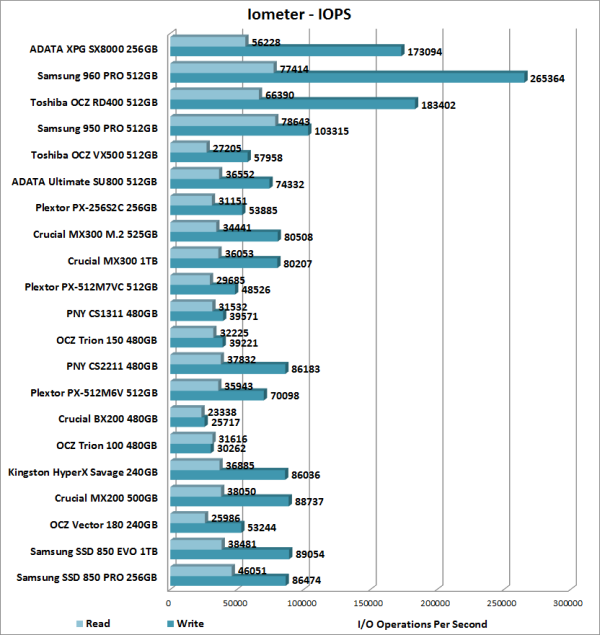
According to ADATA, the 256GB XPG SX8000 is capable of up to 85,000 IOPS when reading and 140,000 IOPS when writing 4K blocks. In our tests, the drive reached 56,228 random read IOPS and 173,094 random write IOPS. As with most drives, the SX8000 performed better at higher queue depths. With the queue depth set to 32, it reached 111,064 random read IOPS and 183,800 random write IOPS.
PCMark 8 - Storage Test:
PCMark 8 is a complete benchmark for Windows. It includes five benchmark tests, each designed around a specific scenario. The storage benchmark measures drive performance using real-world traces recorded from Adobe Creative Suite, Microsoft Office and a selection of popular games.
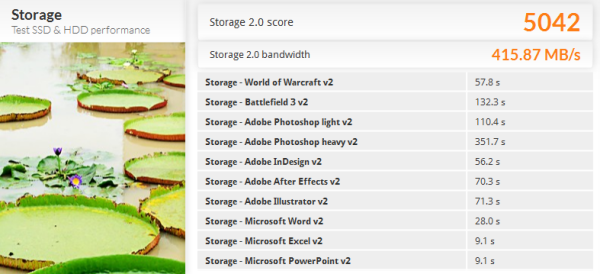
PCMark 8 also includes a consistency test which measures the performance consistency and degradation tendency of a storage system. The test reports the performance level at the start, the degraded steady-state and the recovered state as well as the number of iterations required to reach the degraded state and the recovered state. For this test, we are focusing on the Adobe Photoshop (Heavy) trace and will look at both the bandwidth and latency of the drive
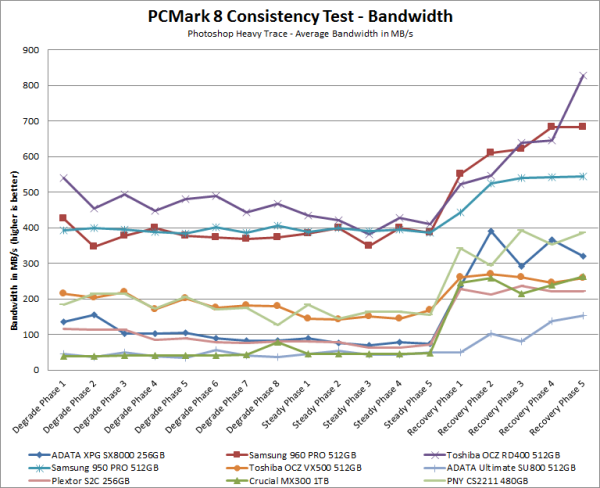
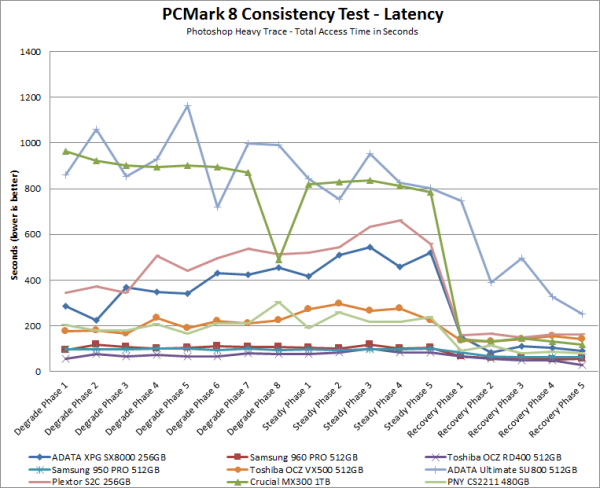
The SX8000 didn't do as well as the other PCIe SSDs in this test. Its bandwidth dropped below 90 MB/s during the degradation and steady phases, pushing its latency well above the 400ms mark. The SX8000's performance increased somewhat during the recovery phase. However, it still lagged behind the 960 PRO and RD400, topping out at only 390 MB/s.
TRIM Performance:
While SSD's offer many benefits, there are some downsides to using flash memory. One of the biggest issues people run into is performance degradation. Over time, an SSD will run out of fresh blocks and will have to write over data the file system has marked as deleted. This procedure is very complicated and can slow an SSD's write speeds considerably.
To fix this problem, most manufacturers have added TRIM support to their SSDs. The TRIM command allows an operating system, such as Windows 7, to tell an SSD which data blocks are no longer in use. Using this information, the drive pro-actively erases these blocks and adds them to the free block pool.
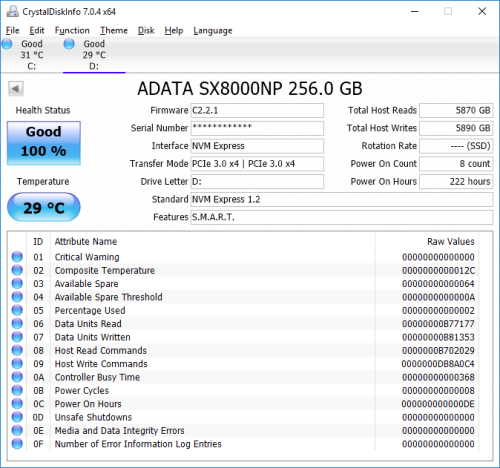
To test the SX8000's TRIM and garbage collection functions, I first put the drive in a "dirty" state. I used Iometer to fill the entire drive and then ran a random write test for 30 minutes. Looking at the screenshot below, you can see that the SX8000's average read and write speeds dropped to 212.7 MB/s and 158.5 MB/s, respectively.
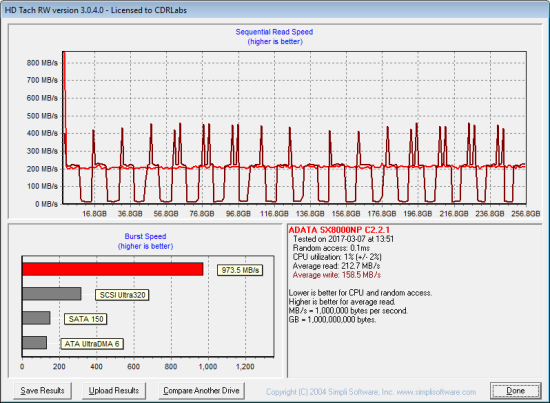
ADATA XPG SX8000 - Dirty
To see how well the SX8000 could recover, I let the computer sit for about 30 minutes and then reran the test. The drive's average read speed climbed up to 277.1 MB/s. However, its write speed lagged behind, averaging out at only 222.4 MB/s.

ADATA XPG SX8000 - After TRIM
Lastly, I used Parted Magic to perform a secure erase on the SX8000. With the drive wiped clean, it had average read and write speeds of 858.7 MB/s and 780.1 MB/s, respectively.
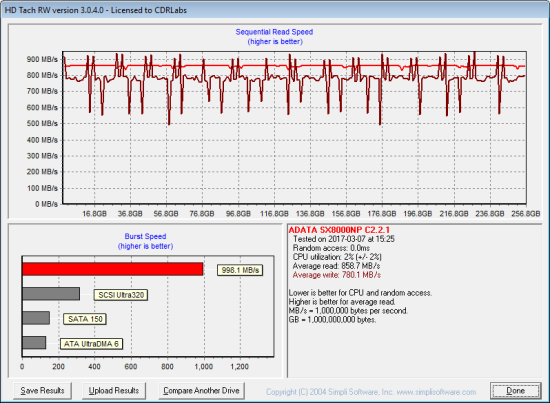
ADATA XPG SX8000 - Secure Erased
Final Thoughts:
ADATA's XPG SX8000 is a great choice for the budget-conscious gamer looking to put an NVMe SSD in their notebook or desktop computer. This compact, M.2 form factor SSD is powered by Silicon Motion's SM2260 controller and is available with up to 1TB of 3D MLC NAND flash. The SX8000 is also equipped with an NVMe 1.2 certified, PCIe Gen3 x4 interface capable of delivering nearly four times the performance of your average SATA 6Gb/s SSD. In our sequential read and write tests, the 256GB version of the drive was able to read at speeds as high as 2,096 MB/s and write at speeds in excess of 1,105 MB/s. The SX8000 also did quite well in our random write tests, producing more than 173,000 IOPS at low queue depths.
Of course, fast read and write speeds aren't the only things the XPG SX8000 has to offer. In addition to a large DRAM cache buffer, the drive uses an intelligent SLC caching algorithm to boost read and write performance. The SX8000 also features advanced LDPC error correction, Data Shaping, and a RAID Engine to ensure data integrity and extend the lifespan of the SSD. To top it all off, the drive is backed by a 5 year warranty.
The XPG SX8000 is available now in 128GB, 256GB and 512GB capacities. Prices on Amazon.com currently range from $90 up to $250, with the 256GB version reviewed here retailing for about $105. The 1TB model has not shipped yet but is expected to hit retailers later this year.

Highs:
- PCIe 3.0 x4 interface with NVMe protocol
- Available in 128GB, 256GB, 512GB and 1TB capacities
- Micron 3D MLC NAND
- Good sequential and random read and write performance
- RAID Engine, Data Shaping and LDPC ECC technologies
- Small M.2 2280 form factor
- Intelligent SLC caching
- Large DRAM cache
- Reasonably priced
- 5 year warranty
Lows:
- Write speed drops considerably when SLC cache is full
- Does not support hardware based encryption




